Elite physics researchers earn international renown
Laser focus
By Jeff Morris
Seek more
Read more about the people behind the research projects at the James R. Macdonald Laboratory.
K-State physicists part of team awarded $90.8 million from National Science Foundation
University scientists unraveling nature of Higgs boson
University researchers contribute to DUNE, the world's biggest neutrino experiment
Science tells us the average blink of an eye lasts about one-tenth of one second, or 100 milliseconds. Colloquially, humans use the phrase “the blink of an eye” to indicate something that happens very quickly. Yet, deep within Cardwell Hall in the James R. Macdonald Laboratory at Kansas State University, physicists are making discoveries using laser pulses that make the blink of an eye look slower than a drawn-out college football television replay.
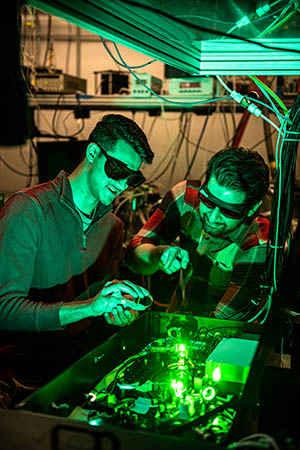 Since the 1920s most motion pictures have been filmed at 24 frames per second, a speed at which our eyes don’t easily discern individual frames. Today, many sports programs run at 30 frames per second or higher to allow for replay. By comparison, an ongoing experiment creating movies of molecular reactions at the Macdonald Lab is currently measuring 10,000 laser pulses — movie frames — per second. Each of those frames is much shorter than a billionth of a second, far beyond the ability of humans to perceive them or modern electronics to resolve them. But soon the lab expects an even more elaborated laser that will produce 100,000 of those ultrashort pulses per second.
Since the 1920s most motion pictures have been filmed at 24 frames per second, a speed at which our eyes don’t easily discern individual frames. Today, many sports programs run at 30 frames per second or higher to allow for replay. By comparison, an ongoing experiment creating movies of molecular reactions at the Macdonald Lab is currently measuring 10,000 laser pulses — movie frames — per second. Each of those frames is much shorter than a billionth of a second, far beyond the ability of humans to perceive them or modern electronics to resolve them. But soon the lab expects an even more elaborated laser that will produce 100,000 of those ultrashort pulses per second.
This quantum research delves into the arcane world of physics, where individual molecules are injected into an ultrahigh vacuum then hit with laser pulses to see how they react. Elemental science seeks to uncover how particles react to light and explain how natural phenomena, such as photosynthesis, work at the most basic level. It is high-impact basic research with real-world implications, and it all happens in the unassuming basement of Cardwell Hall in the prototypical midwestern college town of Manhattan, Kansas.
Lab Director Artem Rudenko serves as the chief scientist behind this effort, the latest in a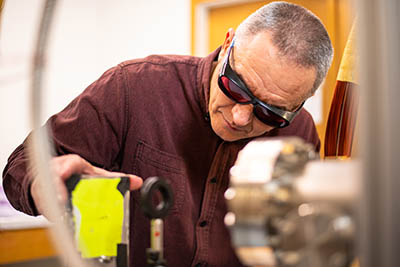 string of world-class physicists who have guided the Macdonald Lab during the past few decades. Rudenko, Cortelyou-Rust professor in the physics department in the College of Arts and Sciences, manages the U.S. Department of Energy, or DOE, grant that funds the lab. In the lab’s nearly 50-year history, scientists have generated more than $100 million in research grants, which is the largest continuous funding for any K-State department.
string of world-class physicists who have guided the Macdonald Lab during the past few decades. Rudenko, Cortelyou-Rust professor in the physics department in the College of Arts and Sciences, manages the U.S. Department of Energy, or DOE, grant that funds the lab. In the lab’s nearly 50-year history, scientists have generated more than $100 million in research grants, which is the largest continuous funding for any K-State department.
As a director, Rudenko oversees two research faculty members and a technical staff of four. He leads a joint effort of nine physics faculty members, all supported by the DOE grant. The lab also supports 15 graduate students and as many as a dozen postdoctoral researchers.
A humble wall plaque near the entrance of the lab pays homage to James R. Macdonald, who joined the physics department in 1968. Macdonald’s spirit of attacking the universe’s toughest problems with gusto is alive and well today. The lab literally hums with the energy of experiments being conducted using some of the world’s most sophisticated lasers and equipment.
“What we are studying happens extremely fast and on a microscopically small-length scale,” Rudenko said.
A shift in focus
The rapid pace of advancements in modern physics and technology led to the Macdonald Lab’s pivot from atomic collisions to molecular and optical science decades ago and has resulted in collaborations with top physicists from around the world.
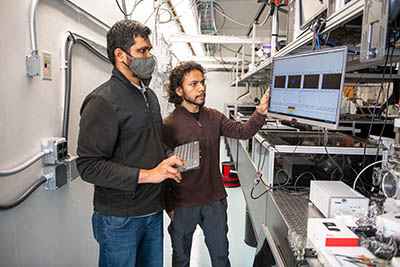 A typical experiment in the lab attempts to measure the effect of light on a single molecule in a vacuum to determine if or how the molecule changes its structure. High-end, commercial lasers substitute for the power of the sun to create data that will eventually lead to 3D graphics describing the reaction. This in turn provides knowledge about some of the most essential mysteries of nature, such as the inner workings of photosynthesis. Millions of data points are created and captured, providing a trove of information for analysis and discovery.
A typical experiment in the lab attempts to measure the effect of light on a single molecule in a vacuum to determine if or how the molecule changes its structure. High-end, commercial lasers substitute for the power of the sun to create data that will eventually lead to 3D graphics describing the reaction. This in turn provides knowledge about some of the most essential mysteries of nature, such as the inner workings of photosynthesis. Millions of data points are created and captured, providing a trove of information for analysis and discovery.
Rudenko’s path to heading an elite lab includes stops at some of the most preeminent physics labs in the world. The Ukrainian native earned his doctoral degree in Moscow then worked at the Max Planck Society in Heidelberg and Hamburg, Germany, before arriving at K-State. All along the way, he encountered K-State researchers who interfaced with their peers at the highest levels of physics.
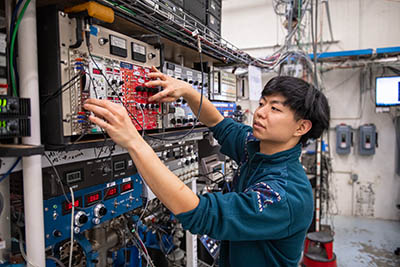 It was a natural fit to join a department that houses multiple current and emeritus university distinguished professors and scientists who regularly work on projects of global impact, such as the Deep Underground Neutrino Experiment, or DUNE, and CERN, home of the Large Hadron Collider.
It was a natural fit to join a department that houses multiple current and emeritus university distinguished professors and scientists who regularly work on projects of global impact, such as the Deep Underground Neutrino Experiment, or DUNE, and CERN, home of the Large Hadron Collider.
K-State continues to build its reputation developed during the past 50 years. Rudenko attributes the continuous DOE funding to consistent scientific output and discovery. He sees the future of the lab with a more robust structure supporting the study of ultrafast molecular reactions. Solidifying an international reputation takes continued technological support and a long-term vision for acquiring talent. In addition to scientific discovery, the lab is a prodigious producer of world-class scientists — many graduate students follow an academic career in national labs or high-tech companies, Rudenko said.
David Rosowsky, K-State vice president for research, sees the need for a higher public profile for the physics department and MacDonald Lab.
“When it comes to physics, Macdonald Lab scientists frequently interact with SLAC, Fermilab, Sanford Underground Research Facility, CERN, NIST and other world-class facilities,” Rosowsky said. “Our scientists and graduate students are highly sought after as collaborators on projects that stretch the very boundaries of science. This lab is a sparkling star in
a constellation of very bright lights. The state of Kansas and the general population need to know about the wonderful asset that provides very real economic benefits to our region.”
Real-world solutions
Tim Bolton serves as the William & Joan Porter professor and K-State physics department head and offers a unique perspective since taking the department helm last summer. For the previous three years, Bolton served in a full-time position on the project management team for DUNE at LBNF, or the Long-Baseline Neutrino Facility. The project is a $3.1 billion science experiment being managed by the DOE Office of High Energy Physics.
Bolton, who has co-authored more than 500 scientific papers, is justifiably proud of the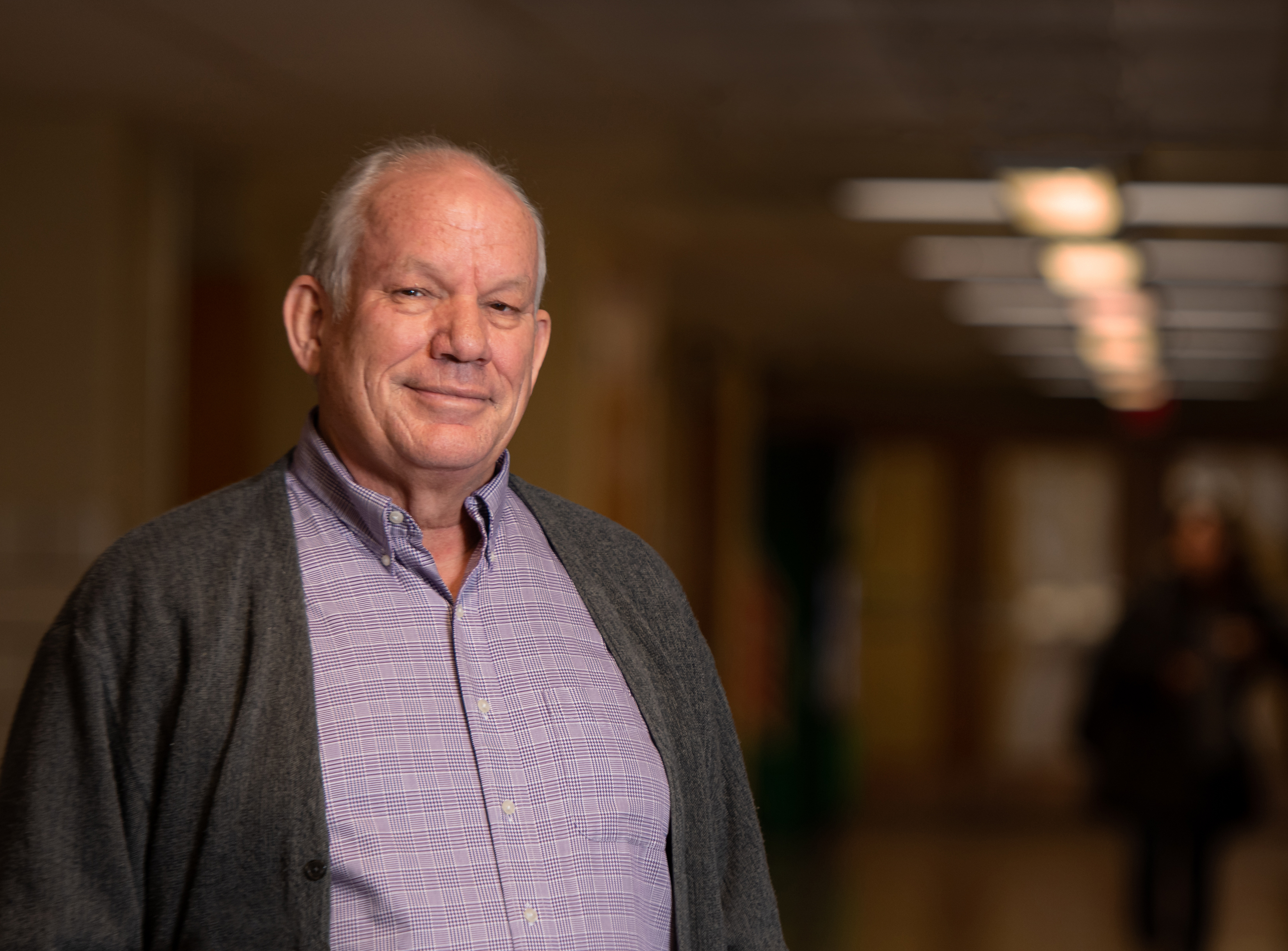 K-State atomic, molecular and optical research teams that routinely work at SLAC National Accelerator Laboratory at Stanford University, Lawrence Berkeley National Laboratory in California and DESY in Hamburg, Germany, among other top scientific locales. But he also points to recent department work on remote sensing, biophysics and materials such as graphene, where discoveries lead to practical, real-world applications.
K-State atomic, molecular and optical research teams that routinely work at SLAC National Accelerator Laboratory at Stanford University, Lawrence Berkeley National Laboratory in California and DESY in Hamburg, Germany, among other top scientific locales. But he also points to recent department work on remote sensing, biophysics and materials such as graphene, where discoveries lead to practical, real-world applications.
Scientists in the physics department conduct research at many levels, from the aforementioned global collaborations to discoveries that have local impact with crucial agriculture and manufacturing industries in Kansas. On-campus collaborations with biologists, agricultural scientists and other researchers happen regularly. The intersection among these disciplines provides fascinating technology, such as the ability to use drones and lasers to measure methane emissions from farms and cattle operations.
Bolton knows basic research is a long game requiring a strategic outlook by those who fund research grants and universities.
“One of the great successes of the United States is that it bought into this basic research and it really pays off consistently,” Bolton said. “Studies of the economic return on basic research show steady returns year after year. It just clicks. You get something back, maybe not in six months, maybe not even in six years, but you get something back.”
The nation, DOE and the state of Kansas are seeing a tremendous return on the investment in K-State and the Macdonald Lab. Rudenko, Bolton, Rosowsky and their teams remain laser-focused on the future.
Back to the lab
Macdonald Lab teams combine high-end laser beams, sophisticated detectors, electronics and software to measure reactions involving individual atoms in molecules moving at unfathomable speeds. The lab contains some of the most advanced instruments in the world that help shed light on the innermost workings of particles. One thing is certain: The lab will continue to evolve and remain a valuable asset to the brilliant scientists who seek new discoveries.
As you leave the basement lab and prepare to ascend the stairs to the lecture halls on the first floor of Cardwell Hall, a sign on the wall sits in silent testament to the history of one of K-State’s most successful labs: The James R. Macdonald Laboratory, An Atomic Physics Research Facility Funded by the U.S. Department of Energy.
James R. Macdonald would be proud of what his namesake has become. But pay attention — if you blink you’ll miss it.